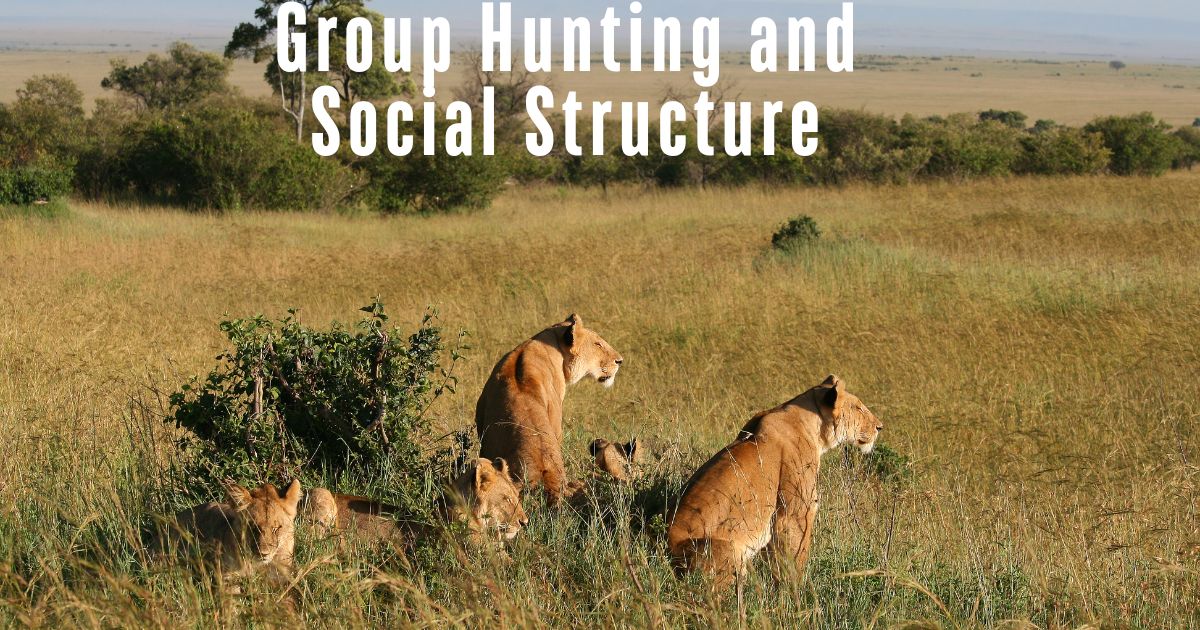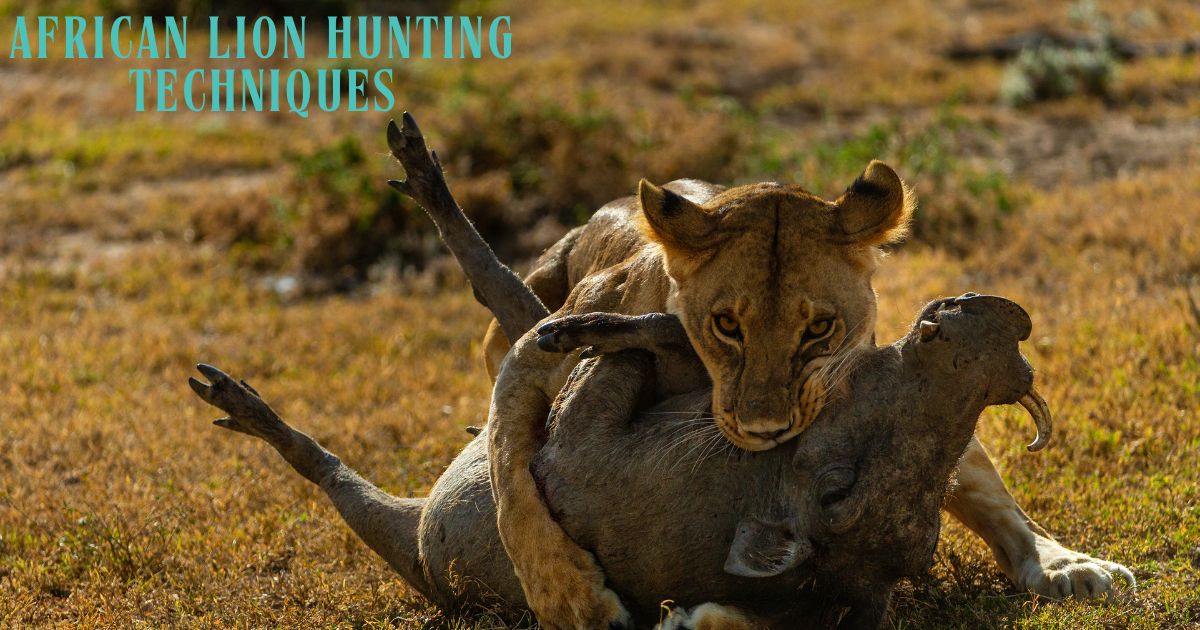Introduction
African Lion Hunting Techniques
African lions are interesting creatures known for their strength, social behavior, and extraordinary hunting skills. They frequently called the “kings of jungle” for a reason. This article will investigate different methods used by making it simple for everybody to understand. We will cover their territory, types of prey, gather hunting techniques, particular hunting techniques, and more. By the end of this article, you’ll have a great understanding of how these wonderful animals hunt to survive.
Table of African Lion Hunting Techniques
| Hunting Technique | Description | Role within Pride | Key Adaptations |
|---|---|---|---|
| Stalking and Ambushing | Lions use stealth to get close to prey before launching a surprise attack. | Stalkers and Ambushers | Powerful muscles, sharp claws, keen senses |
| Chasing and Running Down | Lions chase prey over short distances to catch them. | Fast runners and endurance hunters | Speed, agility, and endurance |
| Encircling and Exhausting Prey | Lions surround prey to limit escape and wear them down before attacking. | Coordinators and drivers | Teamwork, strategic positioning, and persistence |
| Solo Hunting | Male lions or nomads hunt alone, targeting smaller prey. | Individual skill and adaptability | Stealth, strength, and adaptability |
| Hunting at Dawn and Dusk | Lions hunt during low light conditions when prey is less vigilant. | Entire pride participates | Crepuscular activity patterns, night vision |
| Hunting in Different Habitats | Techniques vary based on environment (e.g., ambushing in dense forests). | Adapting to local terrain | Versatility and flexibility in hunting methods |
| Cooperative Hunting | Lions work together, using roles like stalkers, drivers, and ambushers. | Coordinated teamwork | Communication, social structure, and strategic planning |
Key Takeaways
1. Lions are opportunistic hunters that target a variety of prey, primarily large herbivores.
2. Group hunting and social structure are crucial for their hunting success, with each member of the pride playing specific roles.
3. Stalking, ambushing, chasing, and encircling are common hunting techniques used by lions.
4. Communication through vocalizations and body language helps lions coordinate their hunts effectively.
5. Lions have a hunting success rate of 25% to 30% for larger prey, with success influenced by various factors.
6. Crepuscular and nocturnal hunting patterns allow lions to hunt effectively during dawn, dusk, and night.
7. Physical and social adaptations make lions formidable hunters, capable of taking down large and dangerous prey.
Habitat and Range
African lions primarily live in the grasslands, savannas, and open woodlands of sub-Saharan Africa. These areas provide the perfect combination of tall grasses for hiding and open spaces chasing prey. Lions can also be found in national parks, game reserves, some rural areas. They have adapted well to these environments, allowing them to hunt effectively and maintain their populations.
Types of Prey
Lions are opportunistic hunters, meaning they will eat whatever prey is available. Their primary targets are large herbivores such as zebras, wildebeests, buffalo, and antelopes. These animals provide a lot of meat, essential for feeding the entire pride. Lions will also hunt smaller animals like hares, birds, and reptiles when larger prey is scarce.
Group Hunting and Social Structure

Group Hunting and Social Structure
One of the most remarkable aspects of lion hunting is their social structure and group hunting behavior. Lions live in groups called pride, which consist of several related females, their young, and one or more dominant males. The females are the primary hunters and work together to catch prey. This cooperation greatly increases their chances of a successful hunt.
Roles within the Pride
Each member of the pride has a specific role during the hunt. Some lions are responsible for stalking and getting close to their prey without being seen. Others ambush the prey from different angles, and some drive the prey towards the waiting lions. This teamwork is crucial for bringing down large, strong animals that would be difficult to catch alone.
Hunting Techniques
Lions use various hunting techniques to capture their prey. Here are some of the most common methods:
Stalking and Ambushing
Lions are excellent at stalking their prey. They use the tall grass and bushes to hide as they get as close as possible to their target without being noticed. Once they are close enough, they launch a surprise attack with a burst of speed, aiming to grab the prey by the throat or neck with their powerful jaws.
Chasing and Running Down
For prey that is fast and tries to run away, lions rely on their speed and endurance. They can chase their prey over short distances, quickly closing in and overpowering them. This technique is particularly effective against animals like antelopes that rely on speed to escape.
Encircling and Exhausting Prey
When hunting larger animals, lions often work together to surround and exhaust their prey. They position themselves around the prey, cutting off escape routes and causing confusion. This method wears down the prey, making it easier for the lions to catch and kill them.
Communication During Hunts
Lions have developed sophisticated ways to communicate during hunts. They use vocalizations, such as roars and grunts, to coordinate their movements. Body language, including tail movements and facial expressions, also plays a crucial role in keeping the pride synchronized Additionally, lions use scent markings to define their territory and signal their presence to other members of the pride.
Hunting Success Rate
Lions are talented hunters, but not each hunt is effective. On average, adult lions have a chasing victory rate of around 25% to 30% when targeting bigger prey This victory rate can vary depending on variables like prey availability, hunting strategies used, and the encounter of the lions included. Despite these challenges, lions are tireless and regularly hunt a few times before making an effective kill.
Hunting Patterns
Lions are most active during the twilight hours of dawn and dusk, known as crepuscular behavior. This timing allows them to take advantage of the low light conditions when many prey species are also active. During the heat of the day, lions typically rest and conserve energy. Although they prefer to hunt at dawn and dusk, lions also hunt at night. Hunting in the dark provides them with the advantage of surprise, as many prey animals are less vigilant during this time.
Adaptations for Hunting
Lions have several physical and social adaptations that make them effective hunters. Their bodies are built for strength and speed, with powerful muscles, sharp claws, and strong jaws equipped with sharp teeth. These physical attributes help them catch and kill their prey efficiently. Socially, the pride structure and cooperative hunting strategies enhance their hunting success, allowing them to tackle larger and more formidable prey.
Challenges and Adaptations
Despite their prowess, lions face several challenges when hunting. Large prey like buffalo and wildebeests can be dangerous, with powerful kicks and horns that can injure or kill a lion. Additionally, the stamina and agility of their prey mean that hunting can be physically demanding and exhausting. To overcome these challenges, lions have developed remarkable adaptations. Their powerful jaws and sharp teeth deliver lethal bites, while their muscular bodies and sharp claws help bring down their prey. The social structure of prides and their coordinated hunting tactics also play a significant role in tackling larger and more formidable prey
Solo Hunting by Male Lions
While lions are known for their group hunting procedures, a few males, especially those without a pride, frequently hunt alone. These solitary males, known as migrants, depend on their individual skills and flexibility to catch prey. Without the support of a pride, solo hunting males have to be particularly stealthy and strategic. They often target smaller and less formidable prey to avoid injury and conserve energy.
Impact of Habitat on Hunting Techniques
The environment where lions live greatly influences their hunting strategies. In dense forests or bushy areas, lions rely more on ambush tactics, using the cover of vegetation to get close to their prey. In open savannas, they may use speed and endurance to chase down prey. Water sources like rivers and lakes can also play a role, with lions sometimes driving prey towards these barriers to trap them.
Human Impact on Lion Hunting Behavior
Human activities, such as habitat destruction and poaching, significantly impact lion hunting behavior. With shrinking habitats, lions are forced into smaller territories, which can lead to increased competition for food. Additionally, human settlements and livestock farming can alter prey availability, sometimes pushing lions to hunt livestock, leading to human-wildlife conflicts. Conservation efforts aim to protect lion habitats and ensure a stable prey population, helping maintain natural hunting behaviors.
FAQs for African Lion Hunting Techniques
1. Why do lions hunt in groups?
Lions hunt in groups to increment their chances of success and take down bigger prey, ensuring sufficient food for the pride (animalwised.com) (African Lions).
2. What is the primary prey of African lions?
African lions fundamentally hunt large herbivores such as zebras, wildebeests, buffalo, and antelopes (African Lions) (animalwised.com).
3. How do lions communicate during hunts?
Lions utilize vocalizations, body language, and scent markings to facilitate their developments and signal their positions during hunts (African Lions).
4. What adjustments help lions hunt?
Lions have effective muscles, sharp claws, and strong jaws. Socially, they utilize cooperative hunting techniques within their prides (African Lions).
5. How does habitat influence lion hunting techniques?
Lions adjust their hunting methods to their environment. In dense woodlands, they depend on ambush strategies, whereas in open savannas, they may utilize speed to chase prey (animalwised.com) (African Lions).
Conclusion
The hunting methods of African lions are a confirmation of their strength, intelligence, and social participation. These wonderful animals have created a range of procedures to ensure their survival in the wild. By working together, communicating successfully, and utilizing their physical ability, lions have become a few of the most effective predators in the animal kingdom. Understanding their hunting behavior not as it were highlights the complexity of their social structure, but the momentous adjustments that have permitted them to flourish in their natural habitats.

